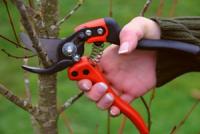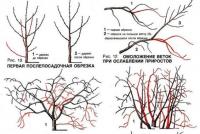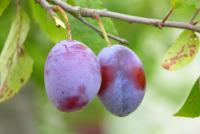Growing garlic: planting garlic for the winter and the timing of harvesting. When and how to properly clean winter garlic
When garlic can be harvested depends on the time it was planted, the weather and when it was harvested. Experienced gardeners determine the duration of harvesting garlic purely intuitively. For those who have no experience, there is good advice: periodically, starting from the first days of July, once a week, dig up several heads in different places of the beds and carefully examine them. The very appearance of garlic will help determine whether it is time to collect it. A good garlic has a formed, resilient head, the lower leaves should be a little yellow. If you wait this moment, it will be problematic to clean the garlic, it will also be very inconvenient to prepare it for the winter.
Determining the optimal harvest time
The possibility of long-term preservation of garlic without sacrificing commercial properties depends on the time of harvest. The mode of the harvesting campaign is established taking into account the peculiarities of the growing season of the crop in these climatic conditions.
Fresh articles about the garden
The maximum growth of the soil head falls on the initial period of drying of the lower leaves. A responsible task for a farmer who wants to harvest a rich and high-quality crop is to accurately determine optimal term collection, after which it is possible to organize the successful storage of garlic for the winter.
- When harvesting too early, the garlic can ripen, but the onion will not have time to grow to the maximum possible size. In this way, you can lose up to 15% of the potential yield.
- When late harvesting garlic has time to ripen. The upper husk will begin to flake and crack, allowing the cloves to fall out of the bulb, dry out and deteriorate. This will lead to a decrease in keeping quality and product attractiveness, reducing the cost and demand for products, a sharp drop in profits from the sale.
Determine the period of harvest on the external signs of the plant:
- for unstretched varieties - lodging of false stems;
- for arrowed varieties - by withering of the upper leaves, cracking of the covering layer of the inflorescence, drying of the outer shells of the garlic head.
When to dig winter garlic
Winter garlic is dug from July 20 to the beginning of August. You must first make sure of maturity, the signal is a massive yellowing and lodging of the lower leaves, this means that winter garlic ripe and ready for harvest. All the nutrients from the aerial parts passed into the head, so leaving the garlic in the ground is no longer necessary.
If in doubt whether garlic has ripened or not, dig a couple of bulbs with a fork and inspect. Good garlic that has reached its required ripeness is firm to the touch, while the cloves will be well separated (but not fall apart), and the scaly sheath easily leaves.
In addition, the ripening of garlic can be calculated by the arrows, at the ends of which the seed box with bulbs matures, when it begins to unfold, then it is time to dig out garlic in the garden. Bulb can be useful if you want to improve the landing. Teeth gradually, year after year, they accumulate infections from which the bulbs are free. 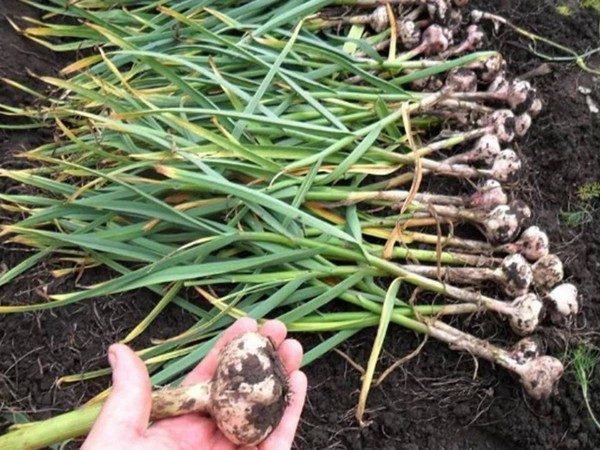
No need to wait for complete drying, otherwise skip dates.
When digging spring garlic
The second name of spring garlic is summer. It begins to ripen in late August, closer to the beginning of September. When you observe yellowing of the stalks and leaves, you can be sure that the garlic is ready for harvesting. Dried root collar, onion hard and dried. These are all signs of ripe spring garlic.
But, if you do not have specialized equipment, then it is quite possible to clean up with your hands. It is necessary to cut the arrows, dig the bulbs a little and carefully, avoiding injuries, remove the garlic from the ground. The crop is laid out in rows to dry out during the day. Then it is collected in a special room, where it is additionally dried for several weeks already with cut stems and roots. It is recommended to leave at least a centimeter of the stem, and when cutting the roots, do not damage the bottom.
If you miss the deadline, the bulbs begin to gradually crack and the teeth fall apart. Then they just start to germinate. The time when the harvest of garlic should be harvested is determined by several criteria. A dense shell has formed around the heads and the outlines themselves are quite distinct. As for the aboveground part, you should find the yellowing of the two lower leaves.
How to remove garlic
Garlic is ready to be harvested when its leaves turn yellowish brown and begin to fall. Another sign of maturity are dry leaves. Garlic collected too late will be poorly stored, and the head will disintegrate into individual teeth that are poorly covered with husk. Such garlic is more susceptible to disease. Dig garlic in clear dry weather, digging in the onion and pulling it out of the soil for the tops. Pay attention to the fact that garlic on any soil is not pulled, but dug! It is necessary to take garlic out of the garden bed carefully in order not to damage the heads. Now collect the garlic, remove the hands with the ground from the roots and bulbs and arrange to dry for 1 -1.5 weeks. After thoroughly drying, the garlic is cut off the roots, leaving no more than 2-3 mm, and the stem, leaving the neck up to 10 cm long. When the heads are dry, they are cleaned of dirt and transferred to a well-ventilated bright room. It’s not worth hitting a dug head on a shovel or other hard object: any dent on teeth can eventually turn into a rotting hearth. After it is necessary to carry out the first selection of heads for seeds, trying to choose the largest and most beautiful. Selected heads are tied in bunches of 10 pcs. and hang out separately from the rest of the garlic, also bundled, on the rope there. Do not break the tops: garlic should dry with the leaves. Garlic is better to remove 5 days earlier than 5 days later. With early harvesting and dosing of bulbs under a canopy for 5 to 10 days, the outflow of nutrients from the leaves to the bulbs continues. At the same time, the mass and density of them increases, 3-4 cover scales of good quality are formed, formed. 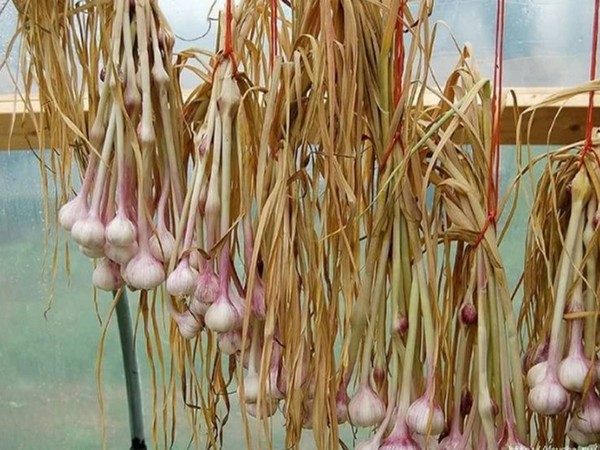 Planting spring garlic on the head
Planting spring garlic on the head
Garlic storage after harvest
Immediately after harvesting garlic can not be put in storage. You should first dry it for a couple of weeks, only then make a bookmark for storage. As a rule, braids are braided or bulbs are simply placed in boxes. In a week, the roots should be cut, the tops should be 1/2 or 3/4 of each garlic, and poured into clean canvas bags, then dry well for 10–12 days, then put in storage. Spring garlic, in contrast to winter, is remarkably stored in warm and cold rooms. A popular storage method is braided garlic braids, which are hung in the kitchen - this is not only convenient, but also beautiful. Store in a cool dark place, allowing air to move freely around bags.
If the garlic for the winter will be stored in the apartment, it is required to take a cool corner, otherwise the heads turn yellow. Putting off the roots for a long period of storage, pruning is done, leaving only 5 cm from the tuber. If storage is planned in the basement or in the refrigerator, the temperature should be kept at + 1-50C
Properly harvested and dried garlic can be stored for six months or more.
For the successful storage of garlic all winter is very important to properly and promptly remove it from the garden. Hence the question: "When to clean the garlic so that it is stored as long as possible?". In principle, there are certain periods in which to harvest, but they can shift depending on the weather, the climatic conditions of the region and other factors. Therefore, experienced growers clean the garlic, focusing on external signs.
As already mentioned, the timely harvest of garlic is the key and guarantee its long-term storage. If the moment has been missed, it can negate all efforts.
If you skip the terms of digging heads, then the following will happen to them:
- integumentary flakes crack, which will lead to the exposure of the teeth - such bulbs quickly dry out or rot, not having survived until January;
- overripe bulbs can release new roots and grow again, which will negatively affect their safety;
- heads can be scattered on individual teeth, which will also shorten their shelf life.
If you remove the garlic from the bed prematurely, then its immature teeth will quickly become soft. Of course, proper drying will help the heads to ripen, but in this case garlic cloves will be slightly shriveled.
Sometimes, gardeners, fearing to skip the harvest, specially dig up the bulbs a week earlier and then dry them in the sun, and this does not affect its taste and storage time.
It is worse if the garlic heads become overripe and their teeth are separated from the arrow. Such a crop cannot be saved for the winter - it needs to be reworked or used rather for planting in the fall.
Ripening garlic
As you know, there are two types of garlic: winter (which is planted in the fall) and spring (summer) - it is planted in the spring, and dug in the summer of the same year. Despite the fact that the ripening period of a certain type is always the same, the timing of its harvesting may vary depending on the region.
For example, in middle lanewhere weather conditions are relatively stable, winter varieties can be dug in mid-July. In the northern regions, harvesting is shifted by 2 and sometimes 3 weeks. Many gardeners when cleaning are guided by moon calendarhowever, this method is acceptable for regions with mild climatebut not suitable for southern or northern areas.
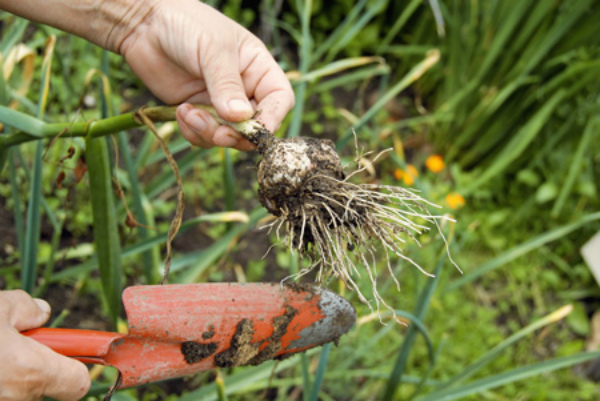
Residents of the Moscow region know very well when digging garlic in the Moscow region. For a variety planted in the fall, this time falls on the last week of July and captures the first of August. Whereas in the Leningrad region, the harvest begins a couple of weeks later, since the climate of this region is colder and more humid. In any case, you need to carefully monitor the condition of the bulbs, and then they themselves will give a signal that they have already matured.
Signs of ripening summer garlic
Spring (summer) garlic begins to ripen in the second half of August, but depending on the weather, it can be harvested in early September. In order not to miss this important point, it is necessary to periodically inspect the beds and the plants themselves. You can also dig up one head and inspect it. Signs of readiness of bulbs for cleaning are:
- yellowing and drying of the leaves;
- lodging stems;
- softening or drying of the root collar;
- when digging a bulb, you can observe a firm, well-formed head with well-shaped teeth, covered with dense, but dry scales.
Signs of ripening winter garlic
Garlic, planted in the fall, traditionally needs to be dug out 100–110 days after the appearance of the first shoots. As a rule, this period corresponds to the last decade of July, but, depending on the climate of the region, may last until early August.
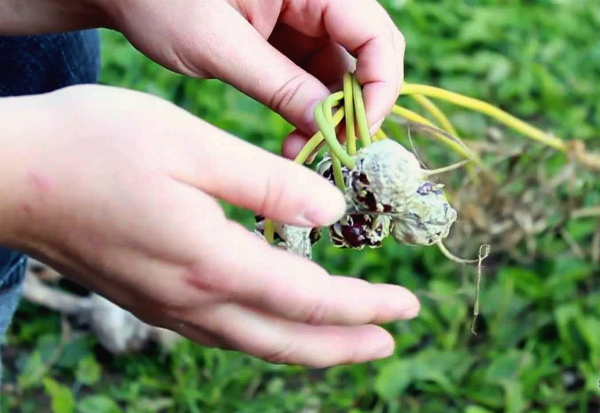
The winter variety differs from the summer one in the ability to release arrows, at the end of which seed pods with multiple small onions are formed. And if the culture is planted not for the purpose of obtaining seeds, then these arrows usually break out so that all the forces of the plant go into the formation of heads.
Experienced gardeners always leave 1-2 arrows, since they also determine the degree of ripeness of garlic.
About ripening winter variety The following symptoms indicate:
- yellowing, withering or drying of the lower leaves - the stems of winter garlic do not fall;
- if there are arrows with bulbs, then a cracked shell is visible on them, under which small sowing bulbs are exposed;
- when digging the head, there is a strong, almost dry scales with purple streaks;
- scales easily removed from the head;
- the teeth are easily separated;
- the lower film from a tooth easily is removed.
![]()
Cleaning
As it has already become clear, timeliness in harvesting is very important, but it is equally important to be able to collect it correctly, since there are many important points in this process:
- You need to dig heads in a dry, preferably sunny day - if the weather is wet or rainy, the bulbs can quickly rot or they need a longer drying time.
- It is better to collect garlic in the morning so that it can dry on the garden in one day.
- Dig bulbs should be forks or undermined with a shovel, so as not to damage the teeth - so they will last longer.
- If the soil is loose, and the heads are easily removed, then it is permissible to pull them out with your hands, but this should be done very carefully.
- After the garlic bulbs have reached, the plant should be laid out on a bed before the evening to dry. Pruning is not recommended for 4–6 days.
- As soon as the heads on the bed are dry, they should be carefully cleaned from the ground and transferred to a dry place for ripening.
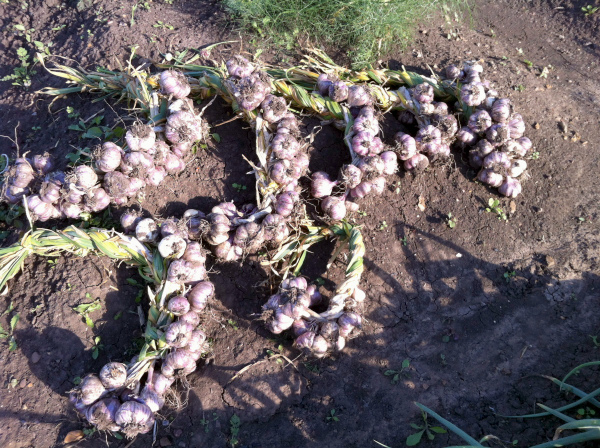
How to store
Under a canopy or in a dry ventilated room, garlic ripens for another 2-3 weeks. After this time, it must be prepared for storage. You should know what is best in a dry cool place, in limbo. There are many ways to preserve a product:
- Bundles, bundles, braids. For this option, the stems should not be cut, on the contrary, the longer and stronger they are, the better.
- Wicker baskets. This method allows you to store heads until the next harvest, as the baskets provide good ventilation. In this case, the stems should be cut to 5–10 cm.
- Boxes, boxes. For this method of storage, the stems are cut to 2–3 cm, the heads are laid in layers and each layer is separated by parchment.
It is the second half of summer, and gardeners are full of worries. It is time for harvesting and now the most important thing is to collect it on time and correctly. Many inexperienced farmers are interested in the timing of garlic collection. So when to clean this garden crop.
The harvest period for garlic falls on the second half of July. Sometimes due to weather conditions, deadlines can shift by two weeks. This is exactly what is happening this year when, due to the cold spring and the first half of summer, the harvest is harvested later. Therefore, garlic is best removed in early August. To be sure of the timing, it is best to look at the dates in the lunar sowing calendar.
The first sign that this vegetable is ready for harvesting is yellowed and dried leaves at the bottom of the stem. The head of garlic should be dense, the film covering it should be easily removable, and the cloves should easily move away from each other. Perederzhivat garlic in the garden can not, otherwise it will begin to germinate again and quickly deteriorate after harvest. Before digging up the whole bed, check several heads for maturity to be sure.
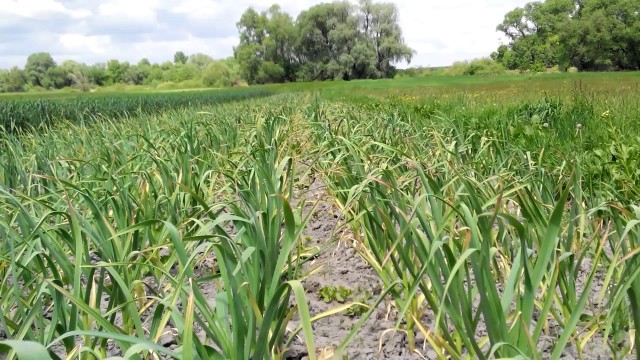
But this year the summer was cold and rainy, so the timing of garlic shifts are shifted by a week or two depending on the region. In any case, it is possible in this matter to focus on the lunar calendar.
Garlic is widely used in the household as a seasoning, giving flavor to many dishes, and also as a medicine for many colds. If garlic is used in cooking, the time of its collection does not matter. To try young juicy cloves, you can dig it from June or in July. To do this, refer to " moon gardener" not necessary.
If garlic needs to be stored for a long time, then it is highly advisable to listen to the lunar adviser of 2017. Quality zubkov plays a very important role. It is stored only until the beginning of winter.
If you listen to the biorhythms of nature, the shelf life can be extended by one and a half months. Competently digging the harvest helps the lunar calendar. So, in July, the best numbers to collect are 5-7, 15-16, 19-20, 23-34 numbers. In August 2017 - 1-3, 11-12, 15-16, 29-30 numbers.
Clearly garlic can be removed when the leaves have dried, and the top will be yellow. But it should immediately be removed from the beds, not left lying on the ground, as garlic cloves can then disintegrate. The best garlic is the one that managed to cover with films in three layers.
Dug out garlic should lie for a week in a warm ventilated room to dry. Then it is cut the stems and roots and cleaned for winter storage.
Immediately give advice: after collecting all the garlic, do not leave it on the garden, especially if it is already ripe. Such garlic will not be able to lie for a long time, and its lobules will disintegrate.
You can dig up garlic when the lower leaves have dried, and the upper ones have already turned yellow. In this case, the head of garlic will be dense, when separating garlic cloves, they easily move away, and the film covering them is easily removed.
How to distinguish between ripe, overripe and unripe garlic? Immature will be soft and loose. And overripe garlic starts to germinate again. When dried, garlic is destroyed and such garlic, like unripe, is not suitable for long-term storage.
The best garlic for storage is that covered with films in three layers. Before picking up all the garlic, check some stuff for maturity and only after that can you dig up the whole bed.
How to determine the ripeness of garlic?
You dig several heads of garlic, pre-raking the ground around and looking at the state of the scales. If the scales are strong and the garlic heads are solid, such garlic is ready for harvesting. During harvesting, first cut off the arrows of garlic, then carefully dig and remove the garlic, shake off the head of garlic and place on the newspaper until it is completely dry. It is better to lay a newspaper with garlic in a warm, dry, ventilated place where it will lie for at least a week. After drying, the stems and roots are removed, leaving a stump about 2 cm, and the roots are cut so as not to damage the garlic plum.
There are a number of features for the 2017 collection of garlic:
Need to know when to break out the arrows in July. To do this, about a month before the planned cleaning, stop all watering. There should not be excess moisture in the ground so as not to create a favorable environment for the development of fungal diseases or the process of decay. During this period, the arrows break off, leaving several representative samples. In 2017, it is advised to do it on such dates: July 1, 2 and 10.
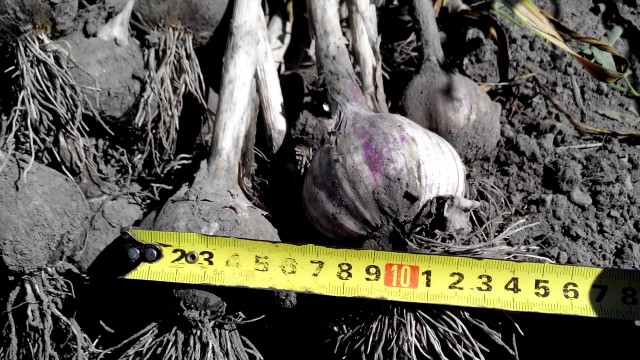
When correctly tie the feathers. This is done to improve yield. Thus, nutrients are redirected to the bulbs themselves. Yellowed feathers are also tied in a knot. With this procedure, it is possible to prevent the emergence of new shoots and growth of foliage. In 2017, it is advised to do it on July 19-20.
The correctness of loosening and hilling of winter garlic. Before harvesting the culture of winter garlic, for 25 days, they are cleared from the ground in the area of the heads. So the bulbs can last longer and the storage of the winter species will last. Loosening the land in 2017 is best done on such dates: from July 3, 4, 8, 30, 31.
Growing any plant, you need to know not only about the comfortable conditions that you need to create for it on the site, but also about the timing of its maturation. That is why it is important not to forget to follow the calendar of the gardener, verifying information even on plants habitual, domesticated long ago, such as garlic, onions, and greens. In this article we will discuss the time of harvesting from the bed of winter garlic, how to dig it up correctly and what you need to know about the care and storage of the crop.
Significant difference in characteristics, growing season and ripening time different varieties garlic often interferes with gardeners. Considering that garlic of different varieties is usually planted on the same bed, the ripening periods differ, sometimes very significantly. As you know, when garlic overrides, it loses a large amount of nutrients, it becomes much more difficult to store. The winter subspecies of this culture does not differ by the duration of storage, so you need to dig it in time.
The harvesting period is in the middle of July. However, a variety of varieties can shift this time by several days and even weeks in both directions. In the case when you are not sure whether the plants planted on a garden belong to the same variety, they need not only different care during growth, but also a different time for ripening.
Usually ripening is determined by yellowing arrows, cracking bulbs, leaf fall. However, most gardeners take care of the plant, cutting off the hands, which means that they can no longer be a reliable indicator. Leaves and bulbs remain, but they can also turn yellow for various reasons: too hot weather, lack of moisture, diseases, pests. Moreover, the combination of signs of maturation can be applied only to plants of the same variety. How to determine when it is time to remove the culture from the site? The answer is simple - dig several bulbs to check.
As a test, you need to carefully remove the ground from the bulbs and inspect it. If it is dense, elastic, husk strong, without cracks and damage - you can remove it from the site. In cases where a visual inspection did not give you reliable information, you need to completely dig out the onion and clean it. In ripe garlic husks are easily separated from the cloves, and they themselves are dense and juicy.
Do not rely only on dates or the lunar calendar when it comes to your landings.
Yes, the harvest time of winter varieties is in the interval between July 15-20 and August 1, but for each plant it is different, so do not be lazy to check whether you should dig or better wait a couple of days.

How to dig
So it's time to dig winter garlic. Best of all, cleaning takes place in a cloudy, dry time. It is advisable to dig out the bulbs in the early morning when it is fresh and cool. Coolness is a necessary condition as the bulbs get sunburn very quickly and become unsuitable for long-term storage.
A week before the time comes to remove the crop from the beds, completely stop watering. Excessive moisture will spoil the bulbs, reducing the already short shelf life. But what is worse - will make winter winter teeth unsuitable for further reproduction. If you fear that the plant will dry up, mulch the earth with peat or organic residues to retain moisture in the soil. Leaving a week dry helps to clean garlic easier and faster.
Arm yourself with a fork with flat teeth, so as not to damage the bulbs in the process of harvesting, because they require careful care during this period. Gently pry the bulbs out of the ground, trying not to damage the roots. When the harvest is over, transfer the crop to the shed or cover it with leaves and tops on the plot. It is important to avoid direct sunlight when the bulbs are on the surface.
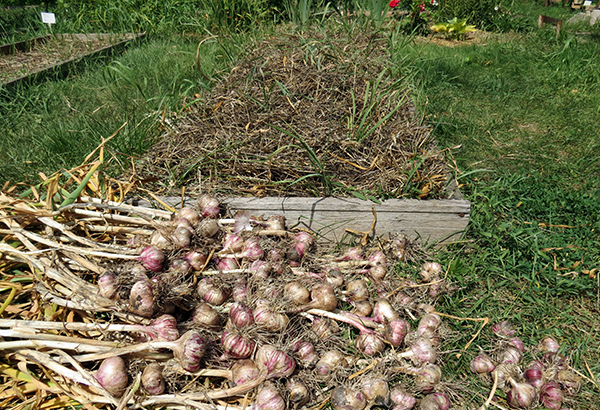
Storage Guide
Care for garlic bulbs enters the active phase when the plant leaves the soil. It is necessary to clean the heads from the ground, trying not to damage root systemand then leave them to dry for ten days. Cover the crop with gauze to protect against insects that will not refuse to eat fresh garlic. Such care is necessary in order to obtain feedstock suitable for consumption and reproduction.
It is best to store garlic heads of winter varieties in bundles. To do this, after the ten-day care is over, cut the roots to 2-3 centimeters, and the stem to 5-6. Pick out uncorroded bulbs, without dents, rot, insects, and form “bouquets” of 10-15 heads each or braid “braid” of 15-20 heads. Subsequently, hang the bundles in a dry, cool place, where they will be usable for 4-5 months.
Another storage option is to clean the onions, cut them into plates or cubes, fold them into molds or plastic bags and send them in the freezer. Thus, you will have a large margin for a variety of culinary dishes.
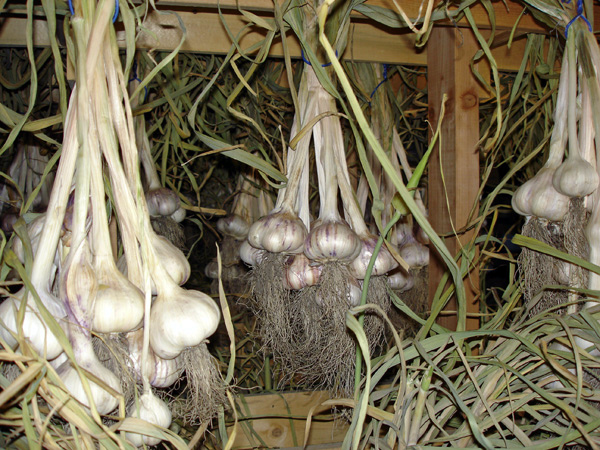
Winter crops are often stored in sunflower, corn or olive oil. To do this, they are cleaned, divided into cloves, and then packaged in sterilized jars. Try not to crush the teeth, so as not to spoil. Fill the jars with oil, cover with vents. You can keep this way for 2-3 months, after which the garlic cloves lose their beneficial properties.
If the oil does not suit you, grind the bulbs into powder. To do this, they must be cleaned, washed and dried, cut into plates, and then roasted in the oven for 20-25 minutes. The resulting garlic "chips" should be ground in a blender or in a mortar. The powder is stored in glass jars, tightly covered with a lid. Food quality is not affected, and storage is greatly facilitated.
The main thing is not to keep the bulbs in a wet place, and also to observe the temperature regime - no more than +5 degrees.
Higher temperatures will cause faster damage to the crop, and will also make the seed unusable.
It is an obligatory additive in meat dishes, sauces and salads. happens and.
It is very simple to distinguish these varieties from each other - there are 5-6 cloves in the winter head, and in the center there is a false stem, in the head of spring garlic there are many cloves (10-20 pieces), the false stem is missing.
Another major difference in the landing time of these. Winter is planted at the end of autumn, closer to winter, and spring - no later than mid-spring. Let's talk more about when to collect, planted in the fall.
When to clean
What does the lunar calendar say
Some agronomists prefer to focus not only on the external signs of ripeness of garlic. They take to assistants.
It is proved that the moon is an assistant in agrarian affairs, listening to the biorhythms of nature, you can harvest the garlic without delay, while maintaining its quality for a long time.
So, ahead of us is garlic harvesting, let's find out when to collect winter garlic according to the lunar calendar:
- In July 2018 best days to collect from will be: 5-7, 15-16, 19-20, 23-24 numbers.
- In August 2018, it is best to collect 1-3, 11-12, 15-16, 29-30 numbers.
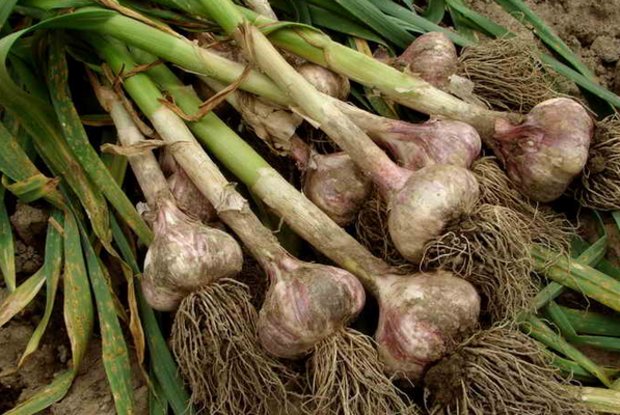 However, it is not enough just to dig out winter garlic. It is necessary to carry out with him some manipulations, again with the help of the lunar calendar, namely:
However, it is not enough just to dig out winter garlic. It is necessary to carry out with him some manipulations, again with the help of the lunar calendar, namely: 
Important!To remove excess moisture in the place of storage of garlic, it is necessary in the container with him to pour a large table salt. She will remove excess moisture.
How to dig
For successful long-term storage of garlic, you should know that light, elevated humidity and temperature will not keep garlic for a long time. Therefore, we must take care of creating optimal conditionscontributing to long-term storage of garlic:
- Humidity. In order not to let germinate, or vice versa, to rot the harvest, it is necessary to maintain humidity at the level of 50-80%.
- Temperature. Garlic does not tolerate high temperatures. Better to be cooler. 3-5 ° C will be sufficient.
- Lighting and air. Keep it in a dark or dark place. Better in a package of several pieces. This can be storage in baskets, boxes, in the form of braids or just a few pieces connected and suspended from the ceiling.
 Did you know? In 1922, during the excavation of the tomb of Tutankhamen, dating back to about 1300 years BC, garlic bulbs were discovered.
Did you know? In 1922, during the excavation of the tomb of Tutankhamen, dating back to about 1300 years BC, garlic bulbs were discovered.
Was this article helpful?
Well no

